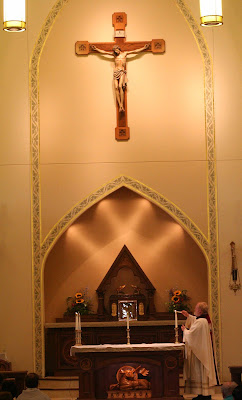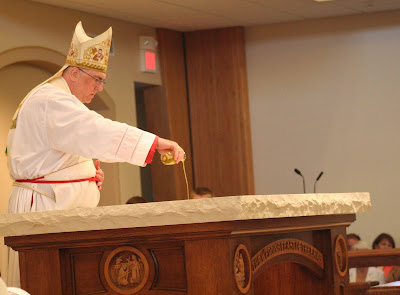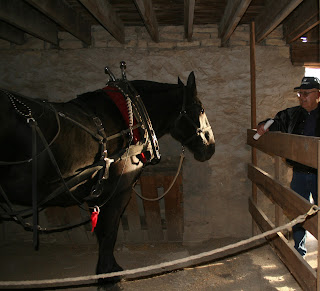Monday, November 5, 2012
Wednesday, August 1, 2012
Remembrance of Flush Picnic
By Paula Ebert
Ask any woman with experience with what
has changed about the St. Joseph Parish picnic, known at the Flush picnic – and
she will mention many things. The main thing is that about nine years ago, the
women began getting together to fry the chickens, for which the picnic is
famous. Before that, each woman fried the chickens at home, and then brought
the chickens in, where it was a difficult task to sort out all the chickens by
the type of meat. In the early days, the women would also have had to skin, and
prepare the chickens at home. Later on, people would purchase chickens already
prepared, and just fry them a home. In addition to frying the chickens at home,
each woman was expected to bring pies and items for the country store. One of
the biggest changes is that the potatoes are produced on site now, as before
that each woman was expected to bring potatoes from home, cut and ready to
cook.
This year, the women of the parish
cooked 2,500 pieces of chicken. This is in a parish with only around 130
registered families.
A look at parish records reveals many
changes, over the years, but at the same time many things have stayed the same.
Jerry Winter came to the picnic on Wednesday, one of the first times since
leaving the parish in 1962. At the same time, he remembered the hat stand, the
basketball toss, and many other things still around. The barrel train is new,
he pointed out. He said that he remembered when there was a dance, and that his
relative, Bill Heptig and his band played many of the dances. The dances were
going at least in 1944, as the records from the notes of the time that the
dance brought in $261. The dinner brought in $534 dollars, and they listed an expense
of $10. That brought the net proceeds to $1,980. Not bad for 1944 dollars. Other
years weren’t as good, with expenses of $40, and net proceeds of $1,144, in
1945. But overall, the 1940s were good years for the picnic.
Records from the 1938 picnic indicate
that the parish brought in $1,273. However, there were $170 in expenses, picnic
and entertainment. However, the total cash on hand for the parish was $1.54 in
the total budget. The next year, the parish cash on hand was $2.64. It did get
better; cash on hand in 1946 was $35 in the total budget.
Bingo has pretty much been a feature of
the picnic all along. Over the years, some things have changed – the buggy
rides were replaced by the Barrel Train, for example. Sometime in the early
1950s, they stopped selling beer. By the 1970s, the dance was gone. Early on one
of the activities was a duck pond, where you could throw rings over the head of
a duck swimming in a pool. But by the mid-1970’s the ducks were gone.
By the 1956 picnic, the doll stand was
being listed separately, and it brought in $158. The doll stand remains today.
By 1985, a hat stand was begun as well, bringing in $462, and while the doll stand
brought in $231. The hat stand remains as well. The country store begun in begin
in the 1940s has always been a favorite. The country store is where
parishioners donate everything from home-made bread, to home preserved foods,
to items from the garden. Members also donate items for sale, now in the
basement of the parish hall.
A change in the last two years has been
an effort to honor the previous people of the parish. Last year, quilts were on
display; and this year “fancy work” such as tatting and embroidery were on
display.
Each year, the women of the parish get
together, and using a donated quilt, hand quilt a quilt for sale. This year,
there were two quilts, one donated by a parishioner, as in previous years, and
another that the women quilted. The quilt the women quilted was called Garden
Glory, and 17 people donated 152 hours over the course of 24 days.
Attendance at the picnic over the years
has remained steady, with numbers of dinners varying from 1,039 in 1960; recently
with 1,124 and this year with 1,050.
Monday, June 4, 2012
Quilt for Saint Joseph
Carrying on a parish
tradition
By Paula Ebert
“The quilt is out of
the quilt frame.” That’s an unusual announcement to hear at the end of Mass,
but not at St. Joseph Parish, Flush. The women of the parish have been quilting
a pieced quilt for many years since the 1920s. They do it as part of the
fundraising for the Church, as the quilt is raffled off during the annual Flush
Picnic, held the last Wednesday in July.
The women gather
together – for the past several years, at the home of the parish priest, Father
Carl Dekat. This year, all told, 17 people donated 152 hours over the course of
24 days.
Nancy Hubbard, who
isn’t a member of the parish but is a local quilting enthusiast, said that she
comes to help with the quilting to “honor the tradition of the women who came
before us.” She mentioned several women of the parish, now deceased, who led
the way with the quilting, including Clara Belle Ebert and Dorothy Ebert. Other
women who helped with quilting who are now deceased included, Florence Noll,
Loretta Straub, Viola Umscheid, Loretta Dekat, Angie Heptig, Eugenia Zoeller, Laura
Deket, Anna Marie Ebert, Mary Winter, Florence Noll, Genevieve Dekat, Mary
Ridder, Elizabeth Umscheid and Alvira Umshheid, to name a few. “That’s why we need to keep it going, to carry
on the tradition,” Hubbard said.
Penny Zweimiller
brought her granddaughter, Jana Kellogg, 11, along to share in the quilting.
“I’ve always wanted to
learn to quilt,” Jana said. She does a lot of hand sewing, making dresses for
her cat. She dived right into the quilt, learning the delicate matter of pulling
the threads so that the quilt was pieced properly. Along the way, she also
learned about ways to do different types of quilts, as when Hubbard described
how to do a blue-jean quilt.
While a quilt can be
quilted in several ways, Marianne King noted that hand stitched quilts are
preferred by many collectors. The quilt provides a chance for the women of the
parish to chat, and get to know one another. There were new quilters this year
members of the community, including Patty Chrest, Gale Seller and Victoria Lacruccua.
Dorothy Ebert’s
daughter, Marty Reed, has provided the quilt top since her mother died in order
to keep the tradition alive. She said she did it in memory of all the women and
their hard work and dedication to the parish.
In addition to the
fried chicken, the picnic is also noted for home-made pies and the country
store with fresh from the garden produce and home canned items. This year, the
parish is going to display “fancy work” done in the past, such as tatting,
crocheting, crewel, embroidery, and more.
Tickets are on sale two
quilts, and can be purchased by calling Marge Magnett at 785-456-1300, or by
writing to 8200 N. Highway 99, Wamego KS, 66541. Tickets are $1 or each or six
tickets for $5. The second one is donated by Dorene Taylor, and hand stitched
by herself. Doreen’s is called “Block in a Block,” and the other quilt done by
the parish community is called “Garden Glory.”
Sunday, August 29, 2010
 Exterior of St. Bernard Parish in Wamego. The church seats 600.
Exterior of St. Bernard Parish in Wamego. The church seats 600. Archbishop Joseph Naumann of Kansas City, Kansas was on hand to dedicate the new church.
Archbishop Joseph Naumann of Kansas City, Kansas was on hand to dedicate the new church. Church pastor, Father John Pilcher lights the candles in the church for the first time.
Church pastor, Father John Pilcher lights the candles in the church for the first time. Using sacramental oils, the archbishop anoints the altar.
Using sacramental oils, the archbishop anoints the altar.St. Bernard Church dedication a work of love for parishioners
Wamego’s St. Bernard Church dedicates “amazing” new church
By Paula Glover
The notion of a “once-in-a-lifetime event” could be the definition of the dedication of St. Bernard Catholic Church in Wamego on Sunday afternoon. After all, the church is intended to last longer than the lifetime of most of the people present when Archbishop Joseph Naumann, of the Archdiocese of Kansas City in Kansas presided over a dedication that is deeply rooted in the tradition of the Catholic Church.
With nearly 500 excited parishioners and community members present, Archbishop Naumann began by leading the parishioners (who had gathered outside in tents in the 95 degree heat) into their new church. There, the dedication Mass included a blessing of the water, a Litany of the Saints, with particular emphasis on Saints Pius X and John Vianney, whose relics were enclosed under the altar and altar of repose.
In his homily, Archbishop Naumann explained how buildings are symbols of what we value.
“We want to give God our best and give God our first fruits,” he said. He used the example of the beautiful churches built during the depression, or in small towns, that are “eloquent expressions of the praise of God in brick and stone.”
He contrasted that to the current emphasis on banks and centers of commerce as symbols of what we value. He noted that on a recent visit to St. Louis, the largest building was a casino. “God does not need us, but we erect good buildings to honor God,” he said. He encouraged all present to “honor God, open your hearts and be heroic witnesses to God as Christen men and women,” using the example of the saints.
An integral part of the dedication is placing of Chrism oil on the altar to dedicate it, and the archbishop poured the oil and spread it carefully over the entire altar. During the ceremony also, candles are lit to symbolize the light of Christ coming to the parish.
The archbishop praised Father John Pilcher, pastor of St. Bernard’s, for his leadership; and Father Pilcher in turn, praised the parishioners for their dedication to the project.
Richard Weixelman said the church was “phenomenal … the way the parish came together to the final project.” He said that 13 years ago, the committee started and one member moved away and two died, but all the others continued the drive for a new church.
One feature of the new church is an effort to utilize items from the old church, including the Crucifix, the stained glass windows (which were fully restored) and the Stations of the Cross.
Jim Meinhardt and his wife, Barbara, were involved during the process. Meinhardt said that the capitol campaign started in earnest two years ago, with a meeting that included about 60 people. One year ago in July, ground was broken for the building. Meinhardt noted a moment he would remember was when the beautiful ceiling was installed, and later on, as the final decorating was accomplished.
Barbara Meinardt noted that Father John was a leader in the restoration, with definite ideas on how the church should be structured. For example, the Tabernacle is in the center behind the altar and all the pews are forward facing. The church also features a large narthex, or gathering space, and a cry room. The church seats 500 and is designed to be able to be expanded.
“The church is amazing,” said parishioner Cindy Diederich. “It took my breath away to see it finished. It was so much more than I anticipated. I just stood there in awe. This really is a once-in-a-lifetime event,” she said, noting for example that nearby St. Joseph Church was dedicated in the early 1900s. “Father John is an amazing priest and our community is blessed to have him,” she added.
Father Plicher, for his part, said “The people did this work, I just happened to be their pastor.”
By Paula Glover
The notion of a “once-in-a-lifetime event” could be the definition of the dedication of St. Bernard Catholic Church in Wamego on Sunday afternoon. After all, the church is intended to last longer than the lifetime of most of the people present when Archbishop Joseph Naumann, of the Archdiocese of Kansas City in Kansas presided over a dedication that is deeply rooted in the tradition of the Catholic Church.
With nearly 500 excited parishioners and community members present, Archbishop Naumann began by leading the parishioners (who had gathered outside in tents in the 95 degree heat) into their new church. There, the dedication Mass included a blessing of the water, a Litany of the Saints, with particular emphasis on Saints Pius X and John Vianney, whose relics were enclosed under the altar and altar of repose.
In his homily, Archbishop Naumann explained how buildings are symbols of what we value.
“We want to give God our best and give God our first fruits,” he said. He used the example of the beautiful churches built during the depression, or in small towns, that are “eloquent expressions of the praise of God in brick and stone.”
He contrasted that to the current emphasis on banks and centers of commerce as symbols of what we value. He noted that on a recent visit to St. Louis, the largest building was a casino. “God does not need us, but we erect good buildings to honor God,” he said. He encouraged all present to “honor God, open your hearts and be heroic witnesses to God as Christen men and women,” using the example of the saints.
An integral part of the dedication is placing of Chrism oil on the altar to dedicate it, and the archbishop poured the oil and spread it carefully over the entire altar. During the ceremony also, candles are lit to symbolize the light of Christ coming to the parish.
The archbishop praised Father John Pilcher, pastor of St. Bernard’s, for his leadership; and Father Pilcher in turn, praised the parishioners for their dedication to the project.
Richard Weixelman said the church was “phenomenal … the way the parish came together to the final project.” He said that 13 years ago, the committee started and one member moved away and two died, but all the others continued the drive for a new church.
One feature of the new church is an effort to utilize items from the old church, including the Crucifix, the stained glass windows (which were fully restored) and the Stations of the Cross.
Jim Meinhardt and his wife, Barbara, were involved during the process. Meinhardt said that the capitol campaign started in earnest two years ago, with a meeting that included about 60 people. One year ago in July, ground was broken for the building. Meinhardt noted a moment he would remember was when the beautiful ceiling was installed, and later on, as the final decorating was accomplished.
Barbara Meinardt noted that Father John was a leader in the restoration, with definite ideas on how the church should be structured. For example, the Tabernacle is in the center behind the altar and all the pews are forward facing. The church also features a large narthex, or gathering space, and a cry room. The church seats 500 and is designed to be able to be expanded.
“The church is amazing,” said parishioner Cindy Diederich. “It took my breath away to see it finished. It was so much more than I anticipated. I just stood there in awe. This really is a once-in-a-lifetime event,” she said, noting for example that nearby St. Joseph Church was dedicated in the early 1900s. “Father John is an amazing priest and our community is blessed to have him,” she added.
Father Plicher, for his part, said “The people did this work, I just happened to be their pastor.”
Appeared in The Mercury, Aug. 27.
Saturday, August 7, 2010
 Pottawamie County Fair photos
Pottawamie County Fair photosAbove, Poultry judge Adam Banks carefully examines a bird to determine the color of the tail feathers.
 Adam Banks examines a Rhode Island Red rooster during the judging.
Adam Banks examines a Rhode Island Red rooster during the judging.
 Education is an important part of 4-H and poultry judge Adam Banks explains what he is looking for as he examines the bird, a family pet.
Education is an important part of 4-H and poultry judge Adam Banks explains what he is looking for as he examines the bird, a family pet.
 Intense concentration on the judge is part of what is required when showing livestock.
Intense concentration on the judge is part of what is required when showing livestock.
 Intermediate showmaship swine participants should keep the swine always in the judge's view.
Intermediate showmaship swine participants should keep the swine always in the judge's view.
Once again this year I treated the county fair as an assignment, and took several shots at the fair. The kids work hard and learn about responsibility - and they also enjoy hanging out with their friends.
Subscribe to:
Posts (Atom)











